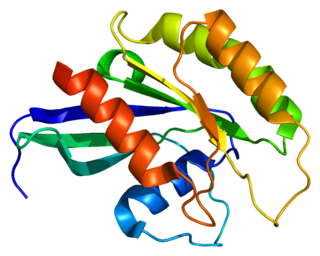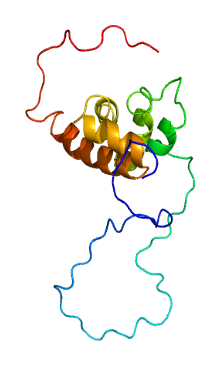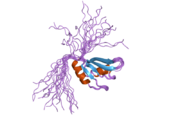
Polyadenylate-binding protein 1 is a protein that in humans is encoded by the PABPC1 gene. The protein PABP1 binds mRNA and facilitates a variety of functions such as transport into and out of the nucleus, degradation, translation, and stability. There are two separate PABP1 proteins, one which is located in the nucleus (PABPN1) and the other which is found in the cytoplasm (PABPC1). The location of PABP1 affects the role of that protein and its function with RNA.

Polyadenylate-binding protein 2 (PABP-2) also known as polyadenylate-binding nuclear protein 1 (PABPN1) is a protein that in humans is encoded by the PABPN1 gene. PABN1 is a member of a larger family of poly(A)-binding proteins in the human genome.

Polyadenylate-binding protein 4 (PABPC4) is a protein that in humans is encoded by the PABPC4 gene.

Poly(A) polymerase alpha is an enzyme that in humans is encoded by the PAPOLA gene.

Chorion-specific transcription factor GCMa is a protein that, in humans, is encoded by the GCM1 gene.

Putative adenosylhomocysteinase 2 is an enzyme that in humans is encoded by the AHCYL1 gene.

Centrosome-associated protein CEP250 is a protein that in humans is encoded by the CEP250 gene. This gene encodes a core centrosomal protein required for centriole-centriole cohesion during interphase of the cell cycle. The encoded protein dissociates from the centrosomes when parental centrioles separate at the beginning of mitosis. The protein associates with and is phosphorylated by NIMA-related kinase 2, which is also associated with the centrosome. Furthermore, CEP135 is also required for the centriolar localization of CEP250.

Beta-crystallin A4 is a protein that in humans is encoded by the CRYBA4 gene.

Protocadherin-8 is a protein that in humans is encoded by the PCDH8 gene.

Surfeit locus protein 6 is a protein that in humans is encoded by the SURF6 gene.

Developmentally-regulated GTP-binding protein 2 is a protein that in humans is encoded by the DRG2 gene.

SH3 domain-binding protein 4 is a protein that in humans is encoded by the SH3BP4 gene.

Kinetochore-associated protein NSL1 homolog is a protein that in humans is encoded by the NSL1 gene.

Gamma-1-syntrophin is a protein that in humans is encoded by the SNTG1 gene.

Forkhead box protein D4 is a protein that in humans is encoded by the FOXD4 gene.

Zinc finger protein 346 is a protein that in humans is encoded by the ZNF346 gene.

Eukaryotic peptide chain release factor GTP-binding subunit ERF3B is an enzyme that in humans is encoded by the GSPT2 gene.

Ras-related protein Rab-26 is a protein that in humans is encoded by the RAB26 gene.

Y-box-binding protein 2 is a protein that in humans is encoded by the YBX2 gene.

High mobility group nucleosome-binding domain-containing protein 4 is a transcription factor that in humans is encoded by the HMGN4 gene.


























